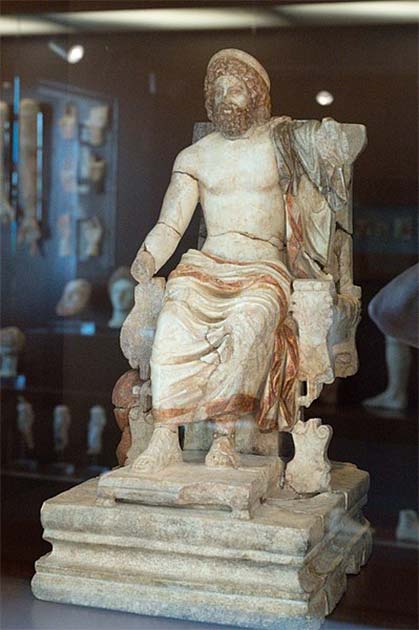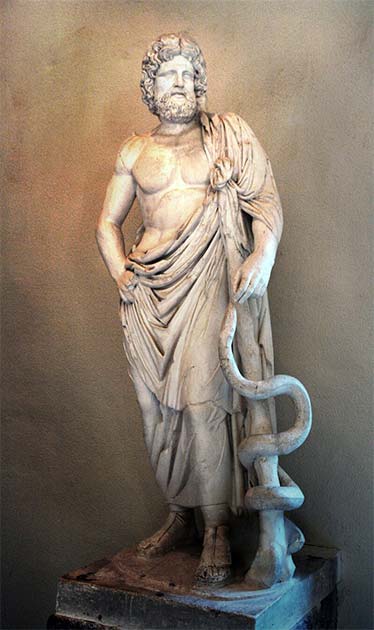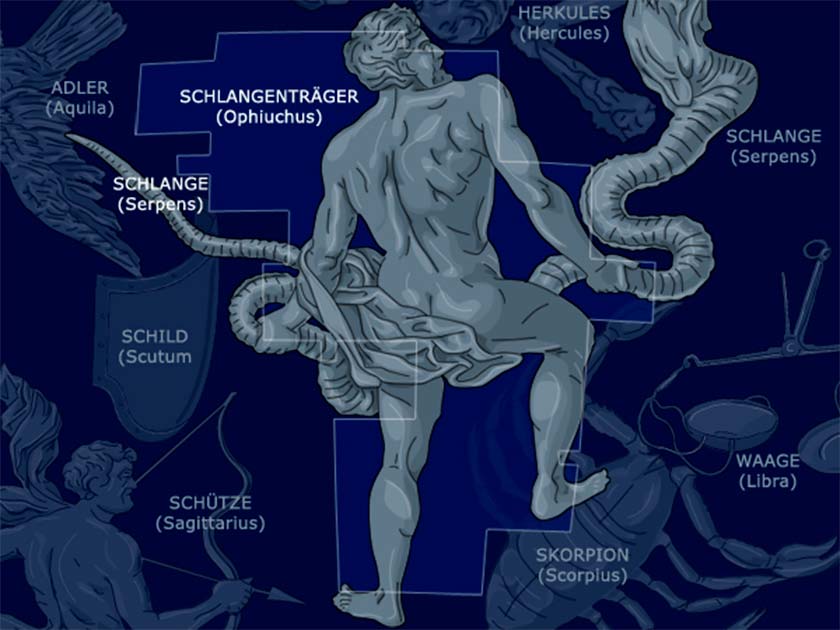A common medical symbol found everywhere is a staff with two snakes winding up the staff and a pair of wings at the top. That symbol is called the caduceus, which has been connected to medicine for centuries.
Except the caduceus has nothing to do with medicine. The caduceus belonged to the god Hermes who was not the god of health or medicine, but his staff is easily confused with a similar staff with a single snake winding up the staff known as the rod of Asclepius.
Asclepius was a healer in ancient Greece, and the medical symbol should be the rod of Asclepius. Who was Asclepius, and why is he associated with medicine when the god of health was Apollo?
Medicine Man
Asclepius is considered a god and hero in Greek mythology; he represents the healing aspect of the medical arts. Asclepius was the son of Apollo (the god of healing and diseases), but his mother changed depending on the authors who recorded the myths.
One of the possible mothers of Asclepius was Coronis, a mortal princess of Thessaly; the other mom might have been a woman named Arsinoe. Many characters in Greek Mythology are named Arsione. Still, in the case of Asclepius, Arsinoe might have been the daughter of Leucippus and the sister of Hilaeria and Phoebe.

There are also accounts that Apollo gave birth to Asclepius without a woman. Asclepius’ mother wasn’t in his life because, in most stories, the mother is unfaithful to Apollo and is killed while pregnant. In most accounts, Apollo swoops in and cuts the baby free from the womb before the mother’s body is engulfed in the flames of a funeral pyre.
Apollo was a single father, and he raised Asclepius as a young man. Asclepius was born with some of the godly healing powers of Apollo, but his father provided further education on how to heal and cure the ill and wounded.
- Pythagoras: Seven Strange Facts about the Philosopher
- What was Kykeon? Greek Beverage that Revealed the Gods
Apollo wasn’t the only individual who provided medical education to Asclepius, the centaur Chiron was also one of his teachers. Chiron was known as the most intelligent and educated centaur, who was renowned for his skill and knowledge of medicine. Chiron was also credited with the discovery of the science of herbs and medicines, the discovery of botany, and pharmacology.
It didn’t take long for Asclepius to become a famous healer throughout Greece.
The Rod of Asclepius
Asclepius is always depicted holding a staff with a snake wrapped around it, known as the rod of Asclepius. There are two different accounts of how and why the snake is wrapped around the staff.
The first account lacks some details, but Asclepius showed “some kind of kindness to a snake”. What that kindness was is unknown, but many assume Asclepius chose not to kill the snake when they crossed paths. In return for the act of kindness, the snake climbed up Asclepius’s rod and “licked Asclepius’s ears clean and taught him secret knowledge.”
The second account of why he holds a rod wrapped with a snake is more complicated. In the book De Astronomica (Poeticon Astronomicon), which is attributed to an unknown author “Hyginus”, Asclepius was “commanded to restore the life of Glaucus”. Glaucus was the son of King Minos and the prince of Crete.
He died after he chased after either a mouse or a ball he was playing with and fell into a jar of honey. Noticing their child was nowhere to be found, Minos sent Asclepius (sometimes named Polyidus) to find the boy.
When Asclepius searched the palace’s wine cellar, he found Glaucus dead inside a cask of honey. Minos demanded the healer bring his son back to life, but Asclepius said no, he couldn’t do it.
Minos was angry and told Ascelpius that the Oracle at Delphi told him that whoever found the boy could bring him back to life. Well… sort of. What the Oracle at Delphi actually told Minos was, “A marvelous creature has been born amongst you: whoever finds the true likeness for this creature will also find the child.” The Oracle at Delphi always gave cryptic responses, and in this case, Minos assumed the Oracle was talking about a new calf that was born to Minos’ herd.

The calf was said to change color thrice daily, from white to red, to black. Asclepius mentioned “that calf changes color just like a ripening mulberry,” and Minos was instantly convinced that Asclepius would find Glaucus and bring him back to life.
King Minos was not taking “no” for an answer from Asclepius and locked him in a cellar or a cage and left him to figure out how to bring the boy back to life. A snake slithered by Asclepius, and in response, the healer took a sword he had and killed the snake.
While sitting in his cell, Asclepius saw another snake slither up to the dead snake, and when it noticed his friend was dead, the snake left. To Asclepius’s surprise, the snake came back with a herb in its mouth that it placed on the body of the dead snake, and it magically came back to life. Asclepius used the same herb to bring Glaucus back to life.
- Is Alepotrypa Cave the Inspiration for the Hades Myth?
- Electrotherapy: Did the Romans use Electricity in their Medicine?
Why a snake stayed on Asclepius’s rod in this story is not mentioned, but it’s still a symbol of the healer. To the ancient Greeks, snakes were seen as revered beings of healing, wisdom, and resurrection.
Asclepius vs. Hades
After learning how to resurrect the dead, Asclepus went around bringing people back to life, including Glaucus, Acpaneus, Lycurgus, and possibly Hippolytus, upon the request of Artemis.
Artemis felt guilty and responsible for the death of Hippolytus, who fell off his chariot and died because he chose to worship Artemis instead of Aphrodite, who set his death into action.
Asclepius was said to have been paid in gold to bring Hippolytus back to life. Some accounts of Asclepius say the only time he brought someone back to life besides Glaucus was Hippolytus. The rest of the time, Asclepius was healing the ill and diseased.
Hades, the bad-tempered little brother of Zeus who commanded the underworld, was unhappy that Asclepius was bringing people back to life, which meant they never passed into the underworld. Hades complained to Zeus that Asclepius was “stealing his subjects,” which was true, but Zeus was more worried about Asclepius teaching “the art of resurrection to other humans”.

To prevent mortals from possibly learning how to resurrect the dead, Zeus killed Asclepius with a thunderbolt. Apollo was furious that Zeus killed his son for something he had neither done nor intended to do.
Asclepius was not Prometheus and was not going to steal the resurrection and teach it to the mortals, yet he was killed, and in an act of revenge, Apollo killed all the Cyclopes, the beings that made Zeus’s thunderbolts. That didn’t go over well, and Apollo was banished from Olympus for a year.
Zeus placed Asclepius’s body among the stars creating the constellation known as Ophiuchus, better known as the serpent holder. Apollo’s request to Zeus was to bring Asclepius back to life, and Zeus placed the healer amidst the stars, making him a god.
Top Image: Asclepius, pictured here with his caduceus, showed skills in healing that seemed divine, and his ability to cure mortals left the gods feeling threatened. Source: zwiebackesser / Adobe Stock